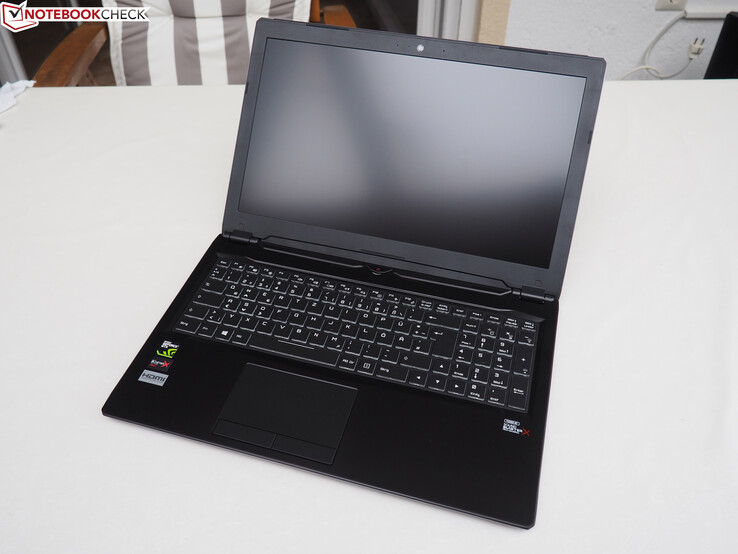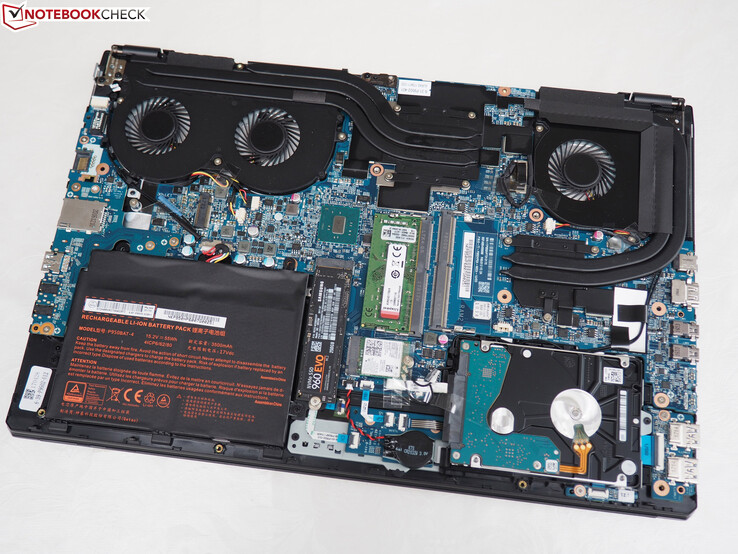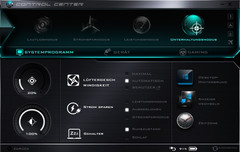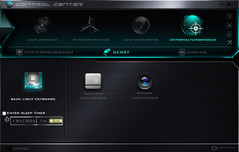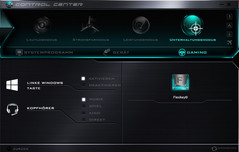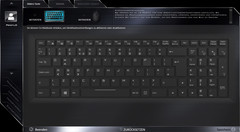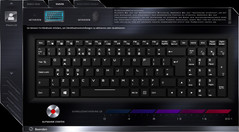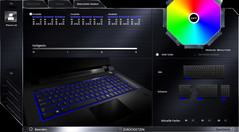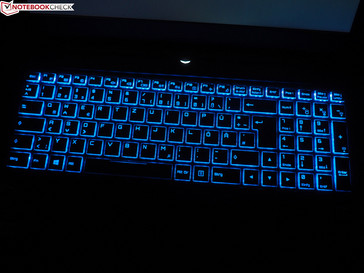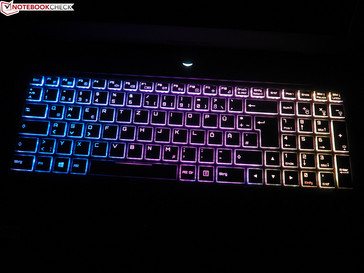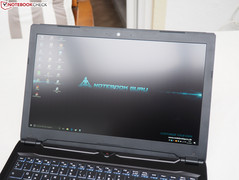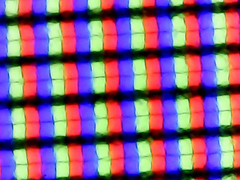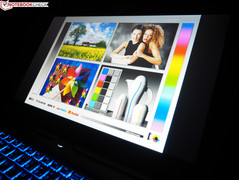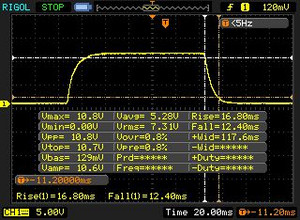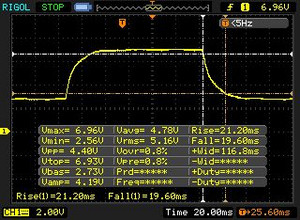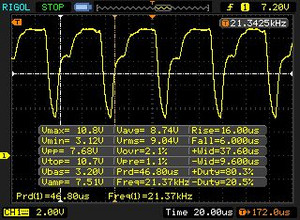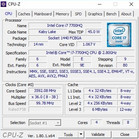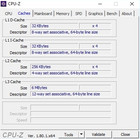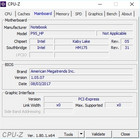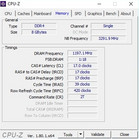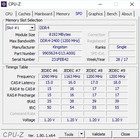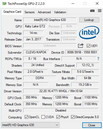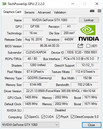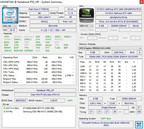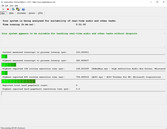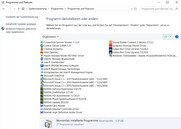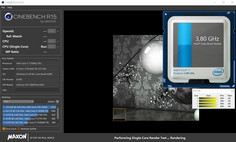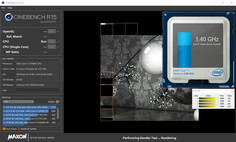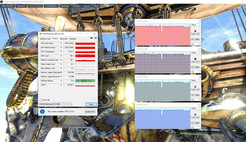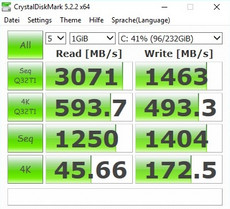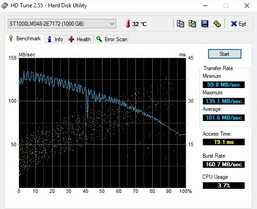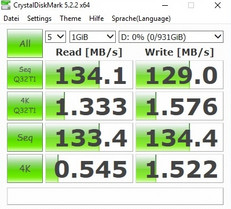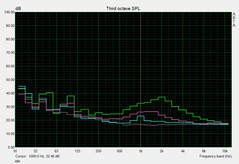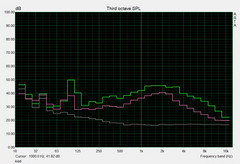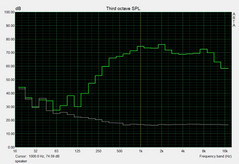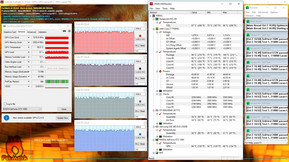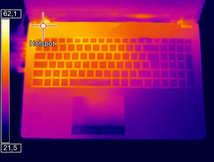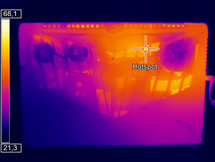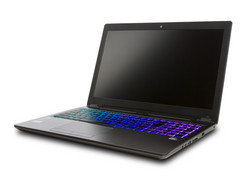Guru Fire KS (Clevo P950HP6) Laptop Review

For the original German review, click here.
The German notebook provider Gaming Guru offers a large number of high-end laptops. They range from chunky 17-inch bolides such as the Mars K (review will be online shortly) all the way to compact 14-inch dwarves such as the Moon K. If you prefer particularly slim cases and travel a lot, you might want to take a look at the Fire KS, which we will be reviewing today.
The 15-inch gaming notebook starts at 1249€ (~$1470) with a Core i7-7700HQ, a GeForce GTX 1060, 8 GB of RAM and a Full HD display. This will not be sufficient for most buyers as the basic configuration comes without a storage device or operating system. Our test unit is equipped with a 250 GB SSD, 1 TB HDD and Windows 10 Home 64-Bit and costs about 1500€ (~$1765). Compared to other GTX 1060 laptops, this is not actually that expensive. Optionally, Gaming Guru also offers further upgrades and accessories. You can find external storage devices, better Wi-Fi adapters, an LTE module, a replacement power supply, a notebook bag and keyboards for other languages online. They also offer a zero-pixel-error guarantee for the display.
We have chosen similarly slim and lightweight 15-inch gaming notebooks as comparison devices for the Fire KS. These include the Eurocom Q5 with a GeForce GTX 1070 Max-Q, the HP Omen 15 with a GeForce GTX 1060 Max-Q and the Acer Nitro 5 with a GeForce GTX 1050 Ti. The most direct competitor is the MSI GS63VR 7RF, which is also equipped with a normal GTX 1060.
Case
Like other Barebone resellers such as Schenker Technologies and Eurocom, Gaming Guru mainly uses the cases from the Taiwanese company Clevo. While Clevo has focused mainly on classic, so rather thick, high-end notebooks in the past, it now seems to be following the current trend towards slimmer gaming laptops. Our device's case (P950HP6) is the best example of this change of direction. It weighs just about 2.2 kg (~4.8 lbs) and is only 18.6 mm (~0.7 in) thick.
Only the MSI GS63VR (1.9 kg, 18 mm/41.8 lbs, 0.7 in) and the Eurocom Q5 (2.2 kg, 18.6 mm/4.8 lbs, 0.7 in) come close to these dimensions. Although the Acer Nitro 5 and the HP Omen 15 also belong to the range of slim gamers, they are still quite a bit heavier and thicker (2.6 to 2.7 kg and 2.5 to 2.7 cm/5.7 to 5.9 lbs and 0.9 to 1 in). The Fire KS is therefore easy to carry around.
We were pleasantly surprised by the build quality. While the Clevo Barebones are often made of plastic, the P950HP6 case is mainly made of aluminum (lid and base unit). Only the display frame and the area around the keyboard are made from plastic. Thanks to the metal, the Fire KS is stable enough, despite its slim build. The base unit hardly gives way, even under strong pressure. The lid, however, makes some nasty and cheap-sounding noises when warped and could have done with a little more stability, particularly as the frame is not completely flush with the display. Talking of workmanship: The gap dimensions between the top and bottom of the case are not perfect - other manufacturers can do a better job here.
We liked the looks of the Fire KS. Although Clevo is daring to create more and more modern designs and has given the P950HP6 a lot of edges and lines, the case is still quite subtle. It becomes a little more noticeable when turned on when the logo and keyboard light up. And finally: The hinges do a good job and can compensate shocks and vibrations, keeping the display firmly in place on train rides, etc. The notebook can easily be opened (max angle 135°) with one hand.
Connectivity
Ports
Except for the missing Thunderbolt 3 port (keyword: eGPU), the available ports are very suitable. As the back is occupied by ventilation slots, Clevo has divided the ports between the two sides. While you can find two audio jacks (headphones and microphone), a USB 3.0 port, a card reader, a SIM slot, an RJ45 port and a Kensington Lock on the right-hand side, the left side features two further USB 3.0 ports and two USB 3.1 Type-C gen 2 ports as well as three digital video outputs in the form of Mini-Display ports and HDMI connectors. These allow you to connect a total of four screens (3x external and 1x internal). The whole package is completed by the mandatory connector for power supply.
Clevo could have done a better job in terms of distributing the ports, however. We find that a lot of them are placed too far to the front and can get in the way when using a mouse and limit the available space.
SD card reader
The performance of the card reader was tested with our reference card from Toshiba. We measured 207 MB/s during sequential reading and 181 MB/s while transferring photos, which is a great result that only the Eurocom Q5 can beat. The HP Omen 15 remains below 100 MB/s, while the MSI GS63VR 7RF cannot even manage 30 MB/s.
| SD Card Reader | |
| average JPG Copy Test (av. of 3 runs) | |
| Eurocom Q5 | |
| Guru Fire KS (Toshiba Exceria Pro SDXC 64 GB UHS-II) | |
| HP Omen 15-ce002ng (Toshiba Exceria Pro SDXC 64 GB UHS-II) | |
| MSI GS63VR 7RF-228US (Toshiba Exceria Pro SDXC 64 GB UHS-II) | |
| maximum AS SSD Seq Read Test (1GB) | |
| Eurocom Q5 | |
| Guru Fire KS (Toshiba Exceria Pro SDXC 64 GB UHS-II) | |
| HP Omen 15-ce002ng (Toshiba Exceria Pro SDXC 64 GB UHS-II) | |
| MSI GS63VR 7RF-228US (Toshiba Exceria Pro SDXC 64 GB UHS-II) | |
Communication
The standard Wi-Fi adapter Intel Wireless-AC 3168 did not do well in our test. First of all, the results that we measured were very unstable and then the Fire KS fell quite far behind the competition in the range test (1 m/39.3 in distance to router). Our comparison devices can double or triple the 270 MB/s (sending) and 252 MB/s (receiving) that our notebook has to offer. We would therefore suggest you upgrade the Wi-Fi module - although part of the reason for these slow speeds might also be connected to the case construction.
| Networking | |
| iperf3 transmit AX12 | |
| Acer Nitro 5 AN515-51-788E | |
| MSI GS63VR 7RF-228US | |
| Eurocom Q5 | |
| HP Omen 15-ce002ng | |
| Guru Fire KS | |
| iperf3 receive AX12 | |
| HP Omen 15-ce002ng | |
| Eurocom Q5 | |
| MSI GS63VR 7RF-228US | |
| Acer Nitro 5 AN515-51-788E | |
| Guru Fire KS | |
Accessories
The scope of delivery is rather lavish. Apart from a cleaning cloth, a driver DVD and a user manual, the manufacturer has also included screws (probably for the 2.5-inch drive bay). On top of that our test unit came with a Windows 10 key and the SSD and RAM packaging. Of course, a power supply is also included. This is comparatively light (0.47 kg/~16.5 oz) and compact (16 x 7.5 x 2.5 cm / 6.3 x 2.9 x 0.98 in) for a 150-watt model.
Maintenance
As we know from most Clevo Barebones, the maintenance possibilities are very good - although you do have to remove the entire bottom of the base unit to reach the insides as there is no maintenance hatch. But apart from unscrewing 11 screws, this is quite easy (be careful to remove the plastic cover of the card reader beforehand!).
Under the hood, you can access every component, from the two DDR4 RAM slots to the storage device (1x M.2 Type 2280 & 1x 2.5-inch drive bay), the Wi-Fi module, the battery or the cooling system. While the CPU is connected to a cooling fan and two heat pipes, the graphics card is being handled by two fans and three heat pipes. In theory, you can also unscrew the keyboard (see the last photo in the gallery), although this would only make sense if there was a real fault or if you wanted to change the language.
Software
The manufacturer has equipped our test unit with a Control Center ideal for tuning enthusiasts. It offers many set-up options starting with fan control and (de-)activating the touchpad, camera and Windows key and going all the way to various sound profiles for headsets. We did all our measurements in entertainment mode with automatic cooling.
Warranty
The device has a 24-month warranty, which you can upgrade to 36 months for about 200€ (~$235). Please see our Guarantees, Return Policies & Warranties FAQ for country-specific information.
Input Devices
Keyboard
Clevo has given our test unit its current chiclet model with three-zone backlighting that has several brightness levels. Typing is good as usual and thanks to the clear pressure point and crisp keystroke, the keyboard offers enough feedback for typing long texts at high speeds. If you do not have a problem with the arrow keys intruding into the main block and number block, you should be quite happy with the layout. Unlike other notebook companies (such as MSI) Clevo mainly keeps to the standard layout.
The average key size of 15 x 15 mm (~0.59 x 0.59 in) is also good. Only the "F"-row, which also offers various other functions, is a little narrower, as usual. You can hear the rather loud typing noises in quiet surroundings. We would like to praise Clevo for its clear lettering. The light white makes it easy to recognize the keys without backlighting during the day. But when you do need it, the backlighting can be easily tuned via the Flexikey software, which also offers tabs for macros and statistics (see screenshots).
Touchpad
We were not quite as happy with the touchpad. The 10.8 x 6.1 cm (~0.42 x 0.24 in) surface is slightly roughened, which does give good feedback and helps you distinguish between the wrist rest and the touchpad, but it makes gliding more difficult. We also feel that precision is not perfect. The multi-touch support worked very well, however. There were no problems when zooming and scrolling using two-finger gestures. The Fire KS touchpad also offers dedicated mouse keys, which is great - although they could be a bit firmer with a clearer pressure point.
Display
If you can make do without G-Sync and 120 Hz, you should be quite happy with the matte Full HD display. Thanks to an average brightness of 304 cd/m², the Fire KS can also be used outdoors. Although it still can be quite difficult to read the screen in (in)direct sunlight.
| |||||||||||||||||||||||||
Brightness Distribution: 93 %
Center on Battery: 312 cd/m²
Contrast: 843:1 (Black: 0.37 cd/m²)
ΔE ColorChecker Calman: 4.16 | ∀{0.5-29.43 Ø4.77}
ΔE Greyscale Calman: 2.53 | ∀{0.09-98 Ø5}
83% sRGB (Argyll 1.6.3 3D)
54% AdobeRGB 1998 (Argyll 1.6.3 3D)
60.5% AdobeRGB 1998 (Argyll 3D)
82.8% sRGB (Argyll 3D)
63.4% Display P3 (Argyll 3D)
Gamma: 2.48
CCT: 6667 K
| Guru Fire KS LG Philips LP156WF6 (LGD046F), 1920x1080, 15.6" | Eurocom Q5 ID: LGD04D4, Name: LG Philips LP156UD1-SPB1, 3840x2160, 15.6" | MSI GS63VR 7RF-228US 3840x2160, 15.6" | HP Omen 15-ce002ng AUO42ED, 1920x1080, 15.6" | Acer Nitro 5 AN515-51-788E LG Philips LP156WF6-SPK6, 1920x1080, 15.6" | |
|---|---|---|---|---|---|
| Display | 6% | -18% | 8% | -29% | |
| Display P3 Coverage (%) | 63.4 | 63 -1% | 48.21 -24% | 65.8 4% | 41.7 -34% |
| sRGB Coverage (%) | 82.8 | 92.7 12% | 72.6 -12% | 90.9 10% | 62.2 -25% |
| AdobeRGB 1998 Coverage (%) | 60.5 | 64.4 6% | 49.81 -18% | 66.5 10% | 43.17 -29% |
| Response Times | 11% | 25% | -7% | 20% | |
| Response Time Grey 50% / Grey 80% * (ms) | 40.8 ? | 32.4 ? 21% | 28 ? 31% | 43.2 ? -6% | 35 ? 14% |
| Response Time Black / White * (ms) | 29.2 ? | 28.8 ? 1% | 23.6 ? 19% | 31.2 ? -7% | 22 ? 25% |
| PWM Frequency (Hz) | 21370 ? | 1351 ? | |||
| Screen | -21% | -50% | 12% | -19% | |
| Brightness middle (cd/m²) | 312 | 287.5 -8% | 274.2 -12% | 304 -3% | 276 -12% |
| Brightness (cd/m²) | 304 | 279 -8% | 263 -13% | 289 -5% | 265 -13% |
| Brightness Distribution (%) | 93 | 87 -6% | 92 -1% | 86 -8% | 91 -2% |
| Black Level * (cd/m²) | 0.37 | 0.65 -76% | 0.44 -19% | 0.26 30% | 0.25 32% |
| Contrast (:1) | 843 | 442 -48% | 623 -26% | 1169 39% | 1104 31% |
| Colorchecker dE 2000 * | 4.16 | 4.5 -8% | 8 -92% | 3.46 17% | 5.06 -22% |
| Colorchecker dE 2000 max. * | 10 | 8.9 11% | 14.6 -46% | 7.72 23% | 10.13 -1% |
| Greyscale dE 2000 * | 2.53 | 4.6 -82% | 9.1 -260% | 2.46 3% | 6.25 -147% |
| Gamma | 2.48 89% | 2.39 92% | 2.24 98% | 2.38 92% | 1.76 125% |
| CCT | 6667 97% | 7393 88% | 5020 129% | 6915 94% | 6873 95% |
| Color Space (Percent of AdobeRGB 1998) (%) | 54 | 59 9% | 45.7 -15% | 59 9% | 40 -26% |
| Color Space (Percent of sRGB) (%) | 83 | 92.3 11% | 72.1 -13% | 91 10% | 62 -25% |
| Total Average (Program / Settings) | -1% /
-11% | -14% /
-33% | 4% /
8% | -9% /
-16% |
* ... smaller is better
The contrast ratio is not bad at 840:1, although some competitors (HP Omen 15, Acer Nitro 5, ...) can reach over 1000:1 due to better black values. Overall, the image of the Fire KS still appears vibrant and natural, which is related to the reasonably good color reproduction. Unlike some notebooks, this one did not have a blue cast and the like ex-works. The results of gray scales, color saturation and color accuracy are also fine, but (Semi)professional buyers might still want to think about calibrating the screen. We were able to reduce the DeltaE-2000 deviation to below 1 (gray scale) and below 3 (Color Checker) with our equipment.
The color space is only mediocre at 83% of the sRGB and 54% of the AdobeRGB color space. "Mediocre" is also the right way to describe the screen's response time. 29.2 ms when changing from black to white and 40.8 ms from gray to gray are typical for an IPS panel. TN panels would be a little faster here, but have worse viewing angles.
The screen does have PWM flickering when the brightness is reduced, but this should not be a problem even for sensitive users due to its very high frequency of 21 KHz. Fortunately, there are no large areas of clouding, but there is slight screen bleeding in the top right corner of the screen, although this was only noticeable in dark scenes.
Display Response Times
| ↔ Response Time Black to White | ||
|---|---|---|
| 29.2 ms ... rise ↗ and fall ↘ combined | ↗ 16.8 ms rise | |
| ↘ 12.4 ms fall | ||
| The screen shows relatively slow response rates in our tests and may be too slow for gamers. In comparison, all tested devices range from 0.1 (minimum) to 240 (maximum) ms. » 77 % of all devices are better. This means that the measured response time is worse than the average of all tested devices (20.2 ms). | ||
| ↔ Response Time 50% Grey to 80% Grey | ||
| 40.8 ms ... rise ↗ and fall ↘ combined | ↗ 21.2 ms rise | |
| ↘ 19.6 ms fall | ||
| The screen shows slow response rates in our tests and will be unsatisfactory for gamers. In comparison, all tested devices range from 0.165 (minimum) to 636 (maximum) ms. » 63 % of all devices are better. This means that the measured response time is worse than the average of all tested devices (31.6 ms). | ||
Screen Flickering / PWM (Pulse-Width Modulation)
| Screen flickering / PWM detected | 21370 Hz | ≤ 95 % brightness setting | |
The display backlight flickers at 21370 Hz (worst case, e.g., utilizing PWM) Flickering detected at a brightness setting of 95 % and below. There should be no flickering or PWM above this brightness setting. The frequency of 21370 Hz is quite high, so most users sensitive to PWM should not notice any flickering. In comparison: 53 % of all tested devices do not use PWM to dim the display. If PWM was detected, an average of 8086 (minimum: 5 - maximum: 343500) Hz was measured. | |||
Performance
Price-conscious gamers who do not necessarily want to invest $2500 to $3500 in a high-end notebook, have found the right device with the Fire KS. The 15-inch device offers well-balanced components that can handle most applications with ease. The device also offers great expandability as the RAM and storage devices can easily be exchanged. CPU and GPU are (as is the case with almost all gaming notebooks) firmly soldered onto the motherboard.
Processor
The Core i7-7700HQ from Intel's Kaby Lake generation is currently the standard CPU for high-performance notebooks.
The quad-core model, produced in the 14-nm process, can work eight threads simultaneously thanks to Hyperthreading. It has nothing to hide compared to its desktop colleagues and can reach between 3.4 GHz (multi-core) and 3.8 GHz (single-core) under load.
| Cinebench R11.5 | |
| CPU Single 64Bit | |
| HP Omen 15-ce002ng | |
| Guru Fire KS | |
| MSI GS63VR 7RF-228US | |
| Eurocom Q5 | |
| Acer Nitro 5 AN515-51-788E | |
| CPU Multi 64Bit | |
| MSI GS63VR 7RF-228US | |
| HP Omen 15-ce002ng | |
| Eurocom Q5 | |
| Guru Fire KS | |
| Acer Nitro 5 AN515-51-788E | |
A look at the comparison table shows no surprises. The Fire KS has similar results as its Core-i7-7700HQ comparison devices in the Cinebench R15 and Cinebench R11.5.
We ran the Cinebench benchmark in a loop to find out whether the 15-inch notebook can keep up its good performance over a prolonged period of time. No matter whether it was 10 or 20 rounds: the score remained similarly high.
System Performance
The system performance was mostly what we expected: While our test unit came last in the PCMark 8 Home test, the Fire KS got a good average in the Work benchmark. The PCMark 10 score was also quite adequate.
| PCMark 8 | |
| Home Score Accelerated v2 | |
| HP Omen 15-ce002ng | |
| Acer Nitro 5 AN515-51-788E | |
| MSI GS63VR 7RF-228US | |
| Eurocom Q5 | |
| Guru Fire KS | |
| Work Score Accelerated v2 | |
| HP Omen 15-ce002ng | |
| MSI GS63VR 7RF-228US | |
| Guru Fire KS | |
| Acer Nitro 5 AN515-51-788E | |
| Eurocom Q5 | |
| PCMark 10 - Score | |
| Eurocom Q5 | |
| HP Omen 15-ce002ng | |
| Guru Fire KS | |
| Acer Nitro 5 AN515-51-788E | |
| PCMark 8 Home Score Accelerated v2 | 3812 points | |
| PCMark 8 Work Score Accelerated v2 | 5100 points | |
| PCMark 10 Score | 4646 points | |
Help | ||
Storage Devices
To make use of SSD technology, but still have sufficient space for your personal collection of games, our configuration offers a mixture of SSD and HDD. The SSD offers 250 GB and is the fast Samsung 960 EVO which has great sequential read (3000 MB/s) and write rates (1400 MB/s) thanks to PCIe/NVMe. Although these results are a little lower than the manufacturers own 960 Pro, it is still a lot faster than some of the SSDs from other manufacturers.
In addition, Gaming Guru has equipped us with a 1TB HDD from Seagate. The Barracuda ST1000LM048 runs at 5400 RPM and manages up to 134 MB/s in the CrystalDiskMark, which is comparatively good for an HDD.
| Guru Fire KS Samsung SSD 960 Evo 250GB m.2 NVMe | Eurocom Q5 Samsung SSD 960 Pro 512 GB m.2 | MSI GS63VR 7RF-228US Samsung SM961 MZVKW512HMJP m.2 PCI-e | HP Omen 15-ce002ng Samsung PM961 MZVLW256HEHP | Acer Nitro 5 AN515-51-788E Intel SSD 600p SSDPEKKW256G7 | |
|---|---|---|---|---|---|
| CrystalDiskMark 5.2 / 6 | 33% | -1% | |||
| Read Seq Q32T1 (MB/s) | 3071 | 3381 10% | 3431 12% | ||
| Write Seq Q32T1 (MB/s) | 1463 | 2075 42% | 1246 -15% | ||
| Read 4K Q32T1 (MB/s) | 594 | 575 -3% | 586 -1% | ||
| Write 4K Q32T1 (MB/s) | 493.3 | 498.7 1% | 486 -1% | ||
| Read Seq (MB/s) | 1250 | 2763 121% | 1419 14% | ||
| Write Seq (MB/s) | 1404 | 2073 48% | 1266 -10% | ||
| Read 4K (MB/s) | 45.66 | 57.2 25% | 47.14 3% | ||
| Write 4K (MB/s) | 172.5 | 202.6 17% | 156 -10% |
Graphics
As with the Core i7-7700HQ, the GeForce GTX 1060 also belongs to the standard repertoire for most gaming notebooks. The chip from Nvidia's Pascal generation that supports DirectX-12 has 1280 shaders units and is supported by 6 GB of GDDR5 VRAM (192-bit interface).
| 3DMark - 1920x1080 Fire Strike Graphics | |
| Eurocom Q5 | |
| Guru Fire KS | |
| MSI GS63VR 7RF-228US | |
| HP Omen 15-ce002ng | |
| Acer Nitro 5 AN515-51-788E | |
| Acer Nitro 5 AN515-51-788E | |
| 3DMark 11 - 1280x720 Performance GPU | |
| Eurocom Q5 | |
| MSI GS63VR 7RF-228US | |
| Guru Fire KS | |
| HP Omen 15-ce002ng | |
| Acer Nitro 5 AN515-51-788E | |
| Acer Nitro 5 AN515-51-788E | |
The Fire KS showed no anomalies in the GPU run. Its performance was similar to that of the MSI GS63VR 7RF in both the 3DMark 11 and the Fire Strike test of the 3DMark 13. The HP Omen 15 with a GTX 1060 Max-Q was overtaken by about 10%, while GTX-1050-Ti notebooks such as the Acer Nitro 5 fell behind by about 30%. Only the GeForce GTX 1070 Max-Q in the Eurocom Q5 was faster and managed to take a 30% lead compared to the normal GTX 1060.
| 3DMark 11 Performance | 11559 points | |
| 3DMark Ice Storm Standard Score | 117404 points | |
| 3DMark Cloud Gate Standard Score | 24328 points | |
| 3DMark Fire Strike Score | 9663 points | |
Help | ||
The system behavior was a little curious under continuous 3D load. While the GPU throttled during the 60-minute stress test with FurMark and Prime 95, the CPU clock rate dropped down to 1.6 GHz after an hour of “The Witcher 3”. Although the frame rate was hardly impacted due to the high graphics performance, this kind of throttling should not occur. After all, this is a high-end notebook made for gaming.
Luckily, we noticed no CPU throttling during shorter phases under load and/or less demanding programs. The Core i7-7700HQ clocked between 3.4 and 3.6 GHz during the Unigine Heaven 4.0 benchmark, for example. An average of 1530 MHz for the GPU core is also great. This means that the GeForce GTX 1060 reaches its expected speed (1405 to 1671 MHz).
Gaming Performance
Most games can be played smoothly even with high details in the native Full HD resolution. In some cases (“FIFA 18”, for example) performance is even good enough for maximum settings. Only very demanding and not so well programmed or optimized games such as “Ark Survival Evolved” force users to choose medium details and/or a lower resolution.
| The Witcher 3 | |
| 1920x1080 Ultra Graphics & Postprocessing (HBAO+) | |
| Eurocom Q5 | |
| MSI GS63VR 7RF-228US | |
| Guru Fire KS | |
| HP Omen 15-ce002ng | |
| Acer Nitro 5 AN515-51-788E | |
| 1920x1080 High Graphics & Postprocessing (Nvidia HairWorks Off) | |
| MSI GS63VR 7RF-228US | |
| Guru Fire KS | |
| HP Omen 15-ce002ng | |
| Acer Nitro 5 AN515-51-788E | |
| low | med. | high | ultra | |
|---|---|---|---|---|
| The Witcher 3 (2015) | 69.8 | 38.4 | ||
| Rocket League (2017) | 136 | |||
| Dirt 4 (2017) | 96.3 | 54.2 | ||
| Playerunknown's Battlegrounds (PUBG) (2017) | 64.1 | 47.7 | ||
| F1 2017 (2017) | 81 | 60 | ||
| Ark Survival Evolved (2017) | 35.4 | 24 | ||
| FIFA 18 (2017) | 167 | 164 |
Emissions
System Noise
We do have to criticize system noise in this device. That Clevo products do not offer perfect fan control is a well-known fact among the gaming community. But Clevo has gone too far with the P950HP6 Barebone. We were left shaking our heads after seeing the high regular noise level of 36 dB(A) and the phases in which the cooling fans turn up to 44 dB(A) while the device is still idling.
Optimizing the power saving settings and changes in the control center only made small improvements. Although we got the cooling fans to stand still in ideal circumstances (we then only heard the HDD), the sudden and extreme changes in RPM continued. In general, the cooling system appears very erratic and does not react to current situations and loads in any comprehensible way. For example, the fans can remain still during one system startup and then turn on full during the next (despite identical conditions). Clevo might improve this in a future BIOS or EC update.
System noise was more normal while under load, although 48 dB(A) in “The Witcher 3” and 54 dB(A) during the stress test is still so loud that you might want to use headphones. The direct competitor from MSI, the GS63VR 7RF remained a lot calmer during almost all tests.
Noise level
| Idle |
| 31 / 36 / 44 dB(A) |
| HDD |
| 31 dB(A) |
| Load |
| 48 / 54 dB(A) |
 | ||
30 dB silent 40 dB(A) audible 50 dB(A) loud |
||
min: | ||
| Guru Fire KS GeForce GTX 1060 Mobile, i7-7700HQ | Eurocom Q5 GeForce GTX 1070 Max-Q, i7-7700HQ | MSI GS63VR 7RF-228US GeForce GTX 1060 Mobile, i7-7700HQ | HP Omen 15-ce002ng GeForce GTX 1060 Max-Q, i7-7700HQ | Acer Nitro 5 AN515-51-788E GeForce GTX 1050 Ti Mobile, i7-7700HQ | |
|---|---|---|---|---|---|
| Noise | 8% | 9% | 8% | 12% | |
| off / environment * (dB) | 29 | 29 -0% | 28.8 1% | 30 -3% | 30.6 -6% |
| Idle Minimum * (dB) | 31 | 31.5 -2% | 33.1 -7% | 30 3% | 30.6 1% |
| Idle Average * (dB) | 36 | 33.8 6% | 33.1 8% | 33 8% | 30.7 15% |
| Idle Maximum * (dB) | 44 | 33.8 23% | 34 23% | 37 16% | 30.7 30% |
| Load Average * (dB) | 48 | 41.7 13% | 37.2 22% | 41 15% | 43 10% |
| Witcher 3 ultra * (dB) | 48 | 41.7 13% | 46.1 4% | 42 12% | 39.7 17% |
| Load Maximum * (dB) | 54 | 54.2 -0% | 47.1 13% | 50 7% | 45.8 15% |
* ... smaller is better
Temperature
Unlike the noise level, temperature values are unremarkable - at least on the outside. We measured a maximum of 52 °C (~125.6 °F, top) and 54 °C (~129.2 °F, bottom) after the one-hour stress test, which is normal compared to the other devices. When the system is not working to capacity, most of the case remains below 30 °C (~86 °F), which means that prolonged periods of typing or surfing on your lap should be no problem.
The hardware has significantly higher values. A combination of FurMark and Prime 95 made the Core i7-7700HQ sweat at up to 100 °C (~212 °F) - which is really at the limit. The easily throttling GeForce GTX 1060 had a maximum temperature of only 68 °C (~154.4 °F).
(-) The maximum temperature on the upper side is 52 °C / 126 F, compared to the average of 40.4 °C / 105 F, ranging from 21.2 to 68.8 °C for the class Gaming.
(-) The bottom heats up to a maximum of 54 °C / 129 F, compared to the average of 43.3 °C / 110 F
(+) In idle usage, the average temperature for the upper side is 26.1 °C / 79 F, compared to the device average of 33.9 °C / 93 F.
(-) Playing The Witcher 3, the average temperature for the upper side is 40.4 °C / 105 F, compared to the device average of 33.9 °C / 93 F.
(±) The palmrests and touchpad can get very hot to the touch with a maximum of 39 °C / 102.2 F.
(-) The average temperature of the palmrest area of similar devices was 28.8 °C / 83.8 F (-10.2 °C / -18.4 F).
| Guru Fire KS GeForce GTX 1060 Mobile, i7-7700HQ | Eurocom Q5 GeForce GTX 1070 Max-Q, i7-7700HQ | MSI GS63VR 7RF-228US GeForce GTX 1060 Mobile, i7-7700HQ | HP Omen 15-ce002ng GeForce GTX 1060 Max-Q, i7-7700HQ | Acer Nitro 5 AN515-51-788E GeForce GTX 1050 Ti Mobile, i7-7700HQ | |
|---|---|---|---|---|---|
| Heat | -3% | 5% | -10% | 16% | |
| Maximum Upper Side * (°C) | 52 | 56.2 -8% | 47 10% | 41.1 21% | |
| Maximum Bottom * (°C) | 54 | 61.2 -13% | 54 -0% | 38.8 28% | |
| Idle Upper Side * (°C) | 28 | 27.8 1% | 28.4 -1% | 36 -29% | 28.7 -3% |
| Idle Bottom * (°C) | 33 | 29.6 10% | 29.6 10% | 40 -21% | 26.9 18% |
* ... smaller is better
Speakers
If you were hoping for a great sound experience due to the Sound Blaster lettering on the case, we are afraid you will be disappointed. Yes, the Fire KS offers better sound than some other gaming notebooks (for example the MSI GS63VR 7RF), but it is still not particularly exciting. There is too little bass and the sound is not balanced well. Compared to a good headset or external speakers, audio content sounds rather flat and unnatural.
But still, the pre-installed Sound Blaster software offers a high variety of settings and optimization options, which allow for very personal tuning, from various sound scenarios to voice settings and equalizers.
Guru Fire KS audio analysis
(+) | speakers can play relatively loud (84 dB)
Bass 100 - 315 Hz
(-) | nearly no bass - on average 24.4% lower than median
(±) | linearity of bass is average (14.4% delta to prev. frequency)
Mids 400 - 2000 Hz
(+) | balanced mids - only 3.5% away from median
(+) | mids are linear (4.6% delta to prev. frequency)
Highs 2 - 16 kHz
(+) | balanced highs - only 1.2% away from median
(+) | highs are linear (3.8% delta to prev. frequency)
Overall 100 - 16.000 Hz
(±) | linearity of overall sound is average (17.2% difference to median)
Compared to same class
» 46% of all tested devices in this class were better, 11% similar, 42% worse
» The best had a delta of 6%, average was 18%, worst was 132%
Compared to all devices tested
» 31% of all tested devices were better, 8% similar, 61% worse
» The best had a delta of 4%, average was 24%, worst was 134%
MSI GS63VR 7RF-228US audio analysis
(±) | speaker loudness is average but good (75 dB)
Bass 100 - 315 Hz
(-) | nearly no bass - on average 25.3% lower than median
(±) | linearity of bass is average (12.4% delta to prev. frequency)
Mids 400 - 2000 Hz
(+) | balanced mids - only 3.3% away from median
(±) | linearity of mids is average (7% delta to prev. frequency)
Highs 2 - 16 kHz
(±) | higher highs - on average 8.1% higher than median
(±) | linearity of highs is average (8.6% delta to prev. frequency)
Overall 100 - 16.000 Hz
(±) | linearity of overall sound is average (28.4% difference to median)
Compared to same class
» 94% of all tested devices in this class were better, 1% similar, 5% worse
» The best had a delta of 6%, average was 18%, worst was 132%
Compared to all devices tested
» 85% of all tested devices were better, 3% similar, 12% worse
» The best had a delta of 4%, average was 24%, worst was 134%
Frequency diagram in comparison (checkboxes can be turned on/off!!)
Energy Management
Power Consumption
Because the Fire KS supports Nvidia's Optimus technology, the 15-inch device can dynamically switch between the graphics unit of the processor (HD Graphics 630) and the dedicated GeForce GPU. This reduces power consumption while idling and during simple actions (Office, video, web, etc.). Values of 6-20 watts while idling are great for a gaming notebook. Optimus cannot offer an advantage during load, and consumption is similar to G-Synch devices. The Fire KS has average consumption rates at 79 to 153 watts - it can even be more energy-efficient than laptops with the GTX 1050 Ti or the GTX 1060 MAX Q.
| Off / Standby | |
| Idle | |
| Load |
|
Key:
min: | |
| Guru Fire KS GeForce GTX 1060 Mobile, i7-7700HQ | Eurocom Q5 GeForce GTX 1070 Max-Q, i7-7700HQ | MSI GS63VR 7RF-228US GeForce GTX 1060 Mobile, i7-7700HQ | HP Omen 15-ce002ng GeForce GTX 1060 Max-Q, i7-7700HQ | Acer Nitro 5 AN515-51-788E GeForce GTX 1050 Ti Mobile, i7-7700HQ | |
|---|---|---|---|---|---|
| Power Consumption | -13% | -45% | -60% | 22% | |
| Idle Minimum * (Watt) | 6 | 9 -50% | 14.5 -142% | 18 -200% | 4.1 32% |
| Idle Average * (Watt) | 11 | 13.5 -23% | 17.3 -57% | 23 -109% | 6.9 37% |
| Idle Maximum * (Watt) | 20 | 13.7 31% | 17.4 13% | 30 -50% | 9.5 52% |
| Load Average * (Watt) | 79 | 87.8 -11% | 93 -18% | 85 -8% | 83 -5% |
| Witcher 3 ultra * (Watt) | 107 | 129 -21% | 128.8 -20% | 96 10% | 108 -1% |
| Load Maximum * (Watt) | 153 | 158.6 -4% | 158 -3% | 126 18% |
* ... smaller is better
Battery Runtime
Thanks to the graphics switching technology, the Fire KS can boast surprisingly long battery runtimes. 5:44 hours of surfing the web via Wi-Fi are just as admirable as 5:26 hours of playing HD films (always at medium brightness). Only very few competitors in the gaming segment can reach similar runtimes. If you leave the 15-inch device running in idle at minimum brightness, it can even keep going for about 10 hours. At maximum brightness and under load, one charge lasts about 2 hours. But you will not really enjoy gaming on battery as the frame rate is very unstable. At 1920x1080 pixels and full details, “The Witcher 3” juddered away at 15 to 30 FPS on battery (~38 FPS on power supply).
| Guru Fire KS GeForce GTX 1060 Mobile, i7-7700HQ, 55 Wh | Eurocom Q5 GeForce GTX 1070 Max-Q, i7-7700HQ, 55 Wh | MSI GS63VR 7RF-228US GeForce GTX 1060 Mobile, i7-7700HQ, 65 Wh | HP Omen 15-ce002ng GeForce GTX 1060 Max-Q, i7-7700HQ, 70 Wh | Acer Nitro 5 AN515-51-788E GeForce GTX 1050 Ti Mobile, i7-7700HQ, 48 Wh | |
|---|---|---|---|---|---|
| Battery runtime | -36% | -34% | -41% | 5% | |
| Reader / Idle (h) | 10 | 7.8 -22% | 6.4 -36% | 4.3 -57% | 14.9 49% |
| H.264 (h) | 5.4 | 3.7 -31% | 5.2 -4% | ||
| WiFi v1.3 (h) | 5.7 | 4.3 -25% | 3.9 -32% | 3.3 -42% | 6.7 18% |
| Load (h) | 2 | 0.8 -60% | 1.3 -35% | 1.3 -35% | 1.1 -45% |
Verdict
Pros
Cons
The Guru Fire KS is a well-made gaming notebook that has some difficulty dealing with badly functioning fan control.
Being rather loud during 3D use is one thing. The continually changing RPM while idling and high regular noise level are another and become quite annoying after a while.
Without this shortcoming, the 15-inch device would definitely be worth a thought. Not only the metal case, but also input devices and the Full HD display are very good except for some small details. The biggest arguments for buying this device are the long battery runtimes and its compact build. There are hardly any high-end notebooks that are comfortable to carry around, so you might want to accept high CPU temperatures in exchange for this advantage. But let us not forget that the Core i7-7700HQ did tend to throttle during our tests after a period of demanding 3D applications.
Overall, the cooling system seems to be a little challenged by the device's hardware equipment. If the Barebone manufacturer Clevo has difficulties creating a suitable cooling system for an ultra-slim gaming notebook with GeForce GTX 1060, it might be better to give the device a millimeter or two extra or to limit themselves to a Core i5-7300HQ and GeForce GTX 1050 Ti or GTX 1060 Max-Q.
Guru Fire KS
- 10/12/2017 v6 (old)
Florian Glaser


